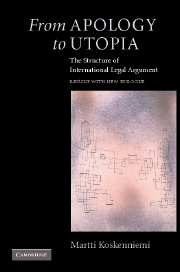Book contents
- Frontmatter
- Contents
- Preface to the reissue
- Acknowledgements
- List of abbreviations
- Introduction
- 1 Objectivity in international law: conventional dilemmas
- 2 Doctrinal history: the liberal doctrine of politics and its effect on international law
- 3 The structure of modern doctrines
- 4 Sovereignty
- 5 Sources
- 6 Custom
- 7 Variations of world order: the structure of international legal argument
- 8 Beyond objectivism
- Epilogue (2005)
- Bibliography and Table of cases
- Index
7 - Variations of world order: the structure of international legal argument
Published online by Cambridge University Press: 16 July 2009
- Frontmatter
- Contents
- Preface to the reissue
- Acknowledgements
- List of abbreviations
- Introduction
- 1 Objectivity in international law: conventional dilemmas
- 2 Doctrinal history: the liberal doctrine of politics and its effect on international law
- 3 The structure of modern doctrines
- 4 Sovereignty
- 5 Sources
- 6 Custom
- 7 Variations of world order: the structure of international legal argument
- 8 Beyond objectivism
- Epilogue (2005)
- Bibliography and Table of cases
- Index
Summary
According to the social conception, law is a social phenomenon, not a set of abstract, unhistorical maxims of natural justice. It is linked to concrete conditions of social life – indeed, it reflects an underlying social reality. But legal concepts and categories are not given by society in any automatic way. “Society” is not simply a lot of people (or States) behaving but includes the ideas through which people (and States) look at what they are doing. Therefore the law, too, must bear a connection to those ideas. So, even as it reflects the social context, it also reflects normative views about that context. In other words, law implies an interpretation of what society is like now and what should be done in order to make it better. To enact consumer protection legislation, for example, implies a social theory, an interpretation according to which, unless legislation were enacted, society's natural condition would overrule consumer interests in some unacceptable fashion.
So, it should be possible to read the law “backwards” in order to reveal the interpretation which it carries of the world in which we live. In this chapter I propose to do just that. I shall look at international law in order to see what kind of an understanding it mediates of present international society and what type of world order it aims to achieve.
- Type
- Chapter
- Information
- From Apology to UtopiaThe Structure of International Legal Argument, pp. 474 - 512Publisher: Cambridge University PressPrint publication year: 2006



